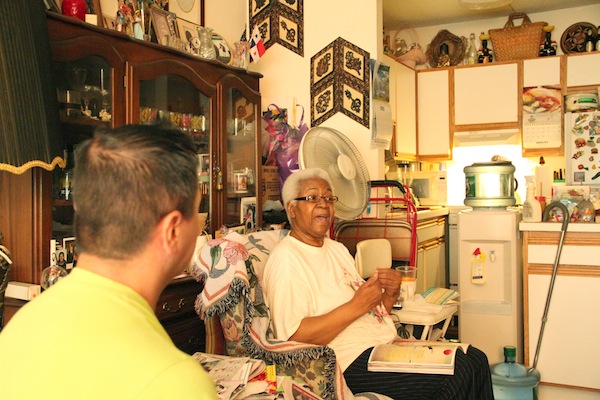
Photo by: Patrick Egan
Case manager Javier Osorio visits Grace Moore in her Brooklyn apartment.
The second Javier Osorio walked into Grace Moore’s Brooklyn apartment early on a mid-July morning, Moore started talking—about Tiger Woods, how to eat on $10 a day, a PBS show on the mysteries of the brain. Only when she took a breath did Osorio get to ask the question that is the crux of case management services: “How are you feeling today?”
Over the din of three oscillating fans fending off the deep summer heat, Moore, 77, said, with a wide, contented smile on her face, “I feel wonderful.”
The services Osorio and all case managers contracted by the city of New York’s Department for the Aging (DFTA) provide seem simple on the surface—arranging home-delivered meals, finding transportation, making sure bills get paid—yet they offer their 18,000 clients (with nearly 1,000 on the waiting list) across the city a valuable and much desired outcome: the chance to age at home, not in a nursing facility.
Each of the past few years, the city has cut case management funding, making it harder to keep the elderly healthier in their homes. That increases the likelihood that a senior will need a nursing home, which costs the state, via Medicaid, many thousands more per person than if he or she had managed to live at home. For 2010, the average annual cost of a semi-private room in a nursing home in New York is about $115,000, while most clients of elderly case management agencies survive on about $13,000 of services.
“Dollar for dollar, it makes sense for the city to do this,” says Bobbie Sackman, director of policy for the Council for Senior Centers and Services, of the cuts to case management, because the city derives the savings while the state gets the bill for the increased nursing home usage. “But policy wise, human wise, system wise, living-in-the-city wise, we’re taking giant leaps backward.”
A history of help
For years, New York City did an admirable job of building a safety net of services for seniors flirting with poverty, according to advocates. Started in 1968 as a three-year trial program to provide discounted transportation, DFTA has since expanded to provide employment services, crime victims’ assistance, health and wellness help and much more, most of which is contracted out to community-based providers. The agency counts on state, city and private funding.
But the Bloomberg administration has cut senior services by $50 million dollars in the past few years, admittedly under extraordinarily trying budgetary pressures, having threatened to cut many millions more. The actual budget reductions deprive vulnerable New Yorkers of much-needed services; the threats scare the elderly, leaving them to wonder when their help will run out. For service providers, bracing for proposed cuts and dealing with real ones take away from the energy they devote to caring for the aging.
The annual rite of slashing elderly programs comes at the front end of a decades-long surge in the city’s senior population. The 2010 census revealed that the over-60 population in New York City increased by 155,000—more than a 12 percent increase—since 2000, to about 1.4 million total. By the year 2030, the total elderly population should sit north of 2 million.
If current figures hold steady, a third of that population will struggle financially, making them ideal candidates for city-funded services.
Will the centers hold?
Those services go well beyond case management, including meals on wheels, special transportation, elder abuse protection and much more.
Perhaps no service fulfills so many needs for the elderly as senior centers. Located throughout the city, these neighborhood gathering places offer subsidized meals, periodic health services, education and a sense of community. During the height of the summer, they also serve as cooling zones for seniors who often lack air conditioning in their home.
“We’ve always felt we can’t turn people away. We just don’t do it,” says Isabel Ching, who directs senior services at the Hamilton-Madison House in the Two Bridges area of the Lower East Side, which serves a predominantly Asian-American clientele. “If we turned them away, what happens if that’s their one meal a day?”
Hamilton-Madison House serves about 120,000 meals annually, 30,000 or so more than is budgeted. Each year, Ching and her staff roll the dice, assuming they’ll find additional funding in the spring, once the budget is tapped.
“A lot of times, people are here because they can’t go any further,” says Ching.
Geography is absolutely crucial when it comes to senior centers. Until last year, Grace Moore had a senior center right across the street in Fort Greene. It closed, and the nearest center is over a half mile away, requiring transportation. Given her health condition—she has diabetes and a problem with her nerves—the trip is usually too much.
“They come because they don’t want to be isolated,” Sackman says. “Hearing them say ‘It’s my second home’ is not a clich








